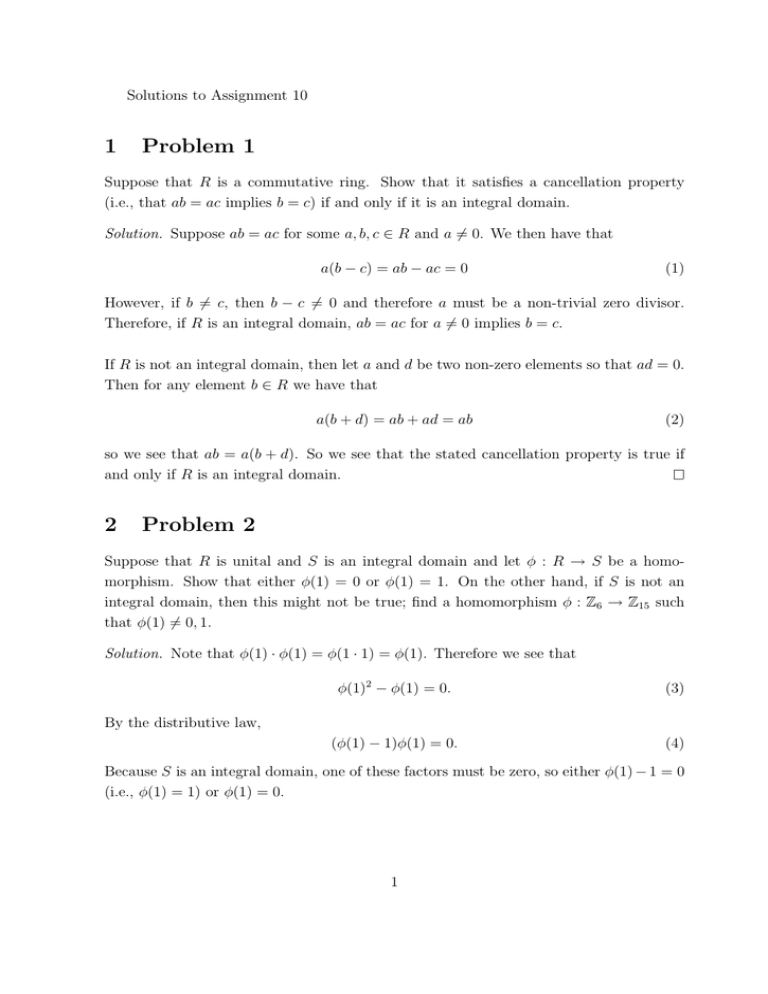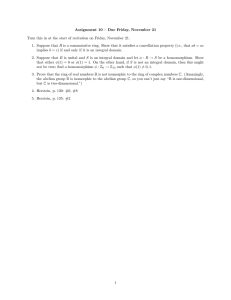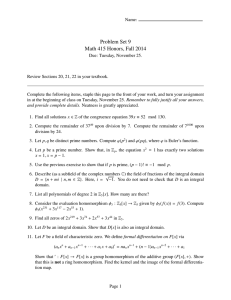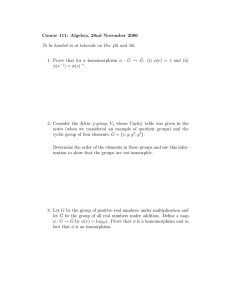1 Problem 1
advertisement

Solutions to Assignment 10 1 Problem 1 Suppose that R is a commutative ring. Show that it satisfies a cancellation property (i.e., that ab = ac implies b = c) if and only if it is an integral domain. Solution. Suppose ab = ac for some a, b, c ∈ R and a 6= 0. We then have that a(b − c) = ab − ac = 0 (1) However, if b 6= c, then b − c 6= 0 and therefore a must be a non-trivial zero divisor. Therefore, if R is an integral domain, ab = ac for a 6= 0 implies b = c. If R is not an integral domain, then let a and d be two non-zero elements so that ad = 0. Then for any element b ∈ R we have that a(b + d) = ab + ad = ab (2) so we see that ab = a(b + d). So we see that the stated cancellation property is true if and only if R is an integral domain. 2 Problem 2 Suppose that R is unital and S is an integral domain and let φ : R → S be a homomorphism. Show that either φ(1) = 0 or φ(1) = 1. On the other hand, if S is not an integral domain, then this might not be true; find a homomorphism φ : Z6 → Z15 such that φ(1) 6= 0, 1. Solution. Note that φ(1) · φ(1) = φ(1 · 1) = φ(1). Therefore we see that φ(1)2 − φ(1) = 0. (3) (φ(1) − 1)φ(1) = 0. (4) By the distributive law, Because S is an integral domain, one of these factors must be zero, so either φ(1) − 1 = 0 (i.e., φ(1) = 1) or φ(1) = 0. 1 On the other hand, if f : Z6 → Z15 , then f (x) = nx, where n = f (1). In order for f to be well-defined, we need n · 6 ≡ 0 (mod 15); this is the case when n = 0, 5, 10. In order for f to be a homomorphism, we need f (x) · f (y) ≡ f (xy) n2 xy ≡ nxy (n2 − n)xy ≡ 0 (mod 15) (mod 15) (mod 15) If x = y = 1, this means n2 − n ≡ 0 (mod 15). By trying the three possibilities above, we find that this is satisfied for n = 0 and n = 10. So the homomorphisms from Z6 to Z15 are the trivial homomorphism that sends all of Z6 to 0 and the homomorphism f (x) = 10x that sends f (1) to 10. 3 Problem 3 Prove that the ring of real numbers R is not isomorphic to the ring of complex number C. (Amazingly, the abelian group R is isomorphic to the abelian group C so you cannot just say ”R is one-dimensional but C is two-dimensional.”) Solution. Let φ be any ring homomorphism from C → R. We know from problem 2 that φ(1) = 0 or φ(1) = 1. If φ(1) = 0, then φ(z) = φ(1)φ(z) = 0 for all z ∈ C and φ is therefore not an isomorphism. If φ(1) = 1, then, in addition, we know that φ(14 ) = φ(1)4 φ(i4 ) = φ(i)4 1 = φ(1) = φ((−1)4 ) = φ(−1)4 φ((−i)4 ) = φ(−i)4 (5) Therefore, φ(1), φ(i), φ(−1), and φ(−i) are all real 4th roots of 1. However, there are only two real 4th roots of 1, those being 1, −1. Therefore φ cannot be one-to-one. 4 Problem 4 p.130 #6. If D is an integral domain and D is of finite characteristic, prove that the characteristic of D is a prime number. Solution. If the characteristic of D is composite. Then we can write that characteristic of D as n · m, where n, m are integers greater than 1. Pick non-zero x, y ∈ D such that 2 nx 6= 0 and such that my 6= 0. Such x, y must exist since otherwise the characteristic of D would be either n, m, both of which are less than n · m. However, (nx)(my) = nm(xy) = 0 (6) Therefore, nx and my are non-zero zero divisors, which contradicts the assumption that D was an integral domain. p.130 #8. If D is an integral domain and if na = 0 for some a 6= 0 in D and some n 6= 0, prove that D is of finite characteristic. Solution. For any element b ∈ D, we have that 0 = (na)b = a(nb) (7) Therefore, since D is an integral domain and a 6= 0 it must be that nb = 0. Therefore D is of characteristic n. 5 Problem 4 p.135 #2. If F is a field, prove that the only ideals of F are (0) and F itself. Solution. For any x, y ∈ F such that x 6= 0, the element yx−1 is in F . Therefore, if I ⊂ F is an ideal of F that contains a non-zero element x, then we have that I contains yx−1 · x = y for all y ∈ F . Therefore I is F itself. So the only ideals of F are (0) and F. 3



